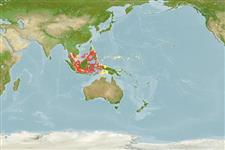Teleostei (teleosts) >
Ovalentaria/misc (Various families in series Ovalentaria) >
Opistognathidae (Jawfishes)
Etymology: Opistognathus: Greek, opisthe = behind + Greek, gnathos = jaw (Ref. 45335); to the very elongate upper jaw of the type species of the genus, Opistognathus nigromarginatus (Ref. 128653); dendriticus: Name from Greek 'dendron' for tree, referring to the tree-like, branching pattern of the cephalic pores.
More on authors: Jordan & Richardson.
Environment: milieu / climate zone / depth range / distribution range
Ecology
Marine; reef-associated; depth range 2 - 40 m (Ref. 90102). Tropical
Western Central Pacific: the Philippines, Malaysia and Indonesia.
Size / Weight / Age
Maturity: Lm ? range ? - ? cm
Max length : 28.0 cm TL male/unsexed; (Ref. 90102)
Short description
Identification keys | Morphology | Morphometrics
Dorsal spines (total): 10 - 11; Dorsal soft rays (total): 13 - 14; Anal spines: 2; Anal soft rays: 11 - 13; Vertebrae: 26 - 27. This species is distinguished by the following characters: a rigid upper jaw lacking flexible lamina posteriorly, extending about 0.6-0.9 eye diameters behind posterior margin of orbit; infraorbitals are relatively slender and tubular, the third infraorbital with moderate lateral opening and wide suborbital shelf; D X-XI,13-14; A II,11-13; scale rows in horizontal series 66-95; vertebrae 10-11 (usually 11) + 16-17. Colouration: dorsum with 6-7 dark blotches along base of dorsal fin, sides with a double row of large pale spots, and spinous dorsal fin with a single black spot between spines 3 to 5-7 (Ref. 128653).
Mouthbrooders. Eggs which are clumped together in a sticky ball get incubated inside the parent's mouth (Ref. 40511).
Life cycle and mating behavior
Maturity | Reproduction | Spawning | Eggs | Fecundity | Larvae
Eggs which are clumped together in a sticky egg ball get incubated inside the parent's mouth (Ref. 40511).
Smith-Vaniz, W.F., 2023. Review of Indo-West Pacific jawfishes (Opistognathus: Opistognathidae), with descriptions of 18 new species. Zootaxa 5252(1):1-180. (Ref. 128653)
IUCN Red List Status (Ref. 130435: Version 2024-2)
Threat to humans
Harmless
Human uses
Tools
Special reports
Download XML
Internet sources
Estimates based on models
Preferred temperature (Ref.
123201): 28.1 - 29.1, mean 28.7 °C (based on 102 cells).
Phylogenetic diversity index (Ref.
82804): PD
50 = 0.5000 [Uniqueness, from 0.5 = low to 2.0 = high].
Bayesian length-weight: a=0.00389 (0.00180 - 0.00842), b=3.12 (2.94 - 3.30), in cm total length, based on all LWR estimates for this body shape (Ref.
93245).
Trophic level (Ref.
69278): 3.7 ±0.6 se; based on size and trophs of closest relatives
Fishing Vulnerability (Ref.
59153): Low vulnerability (18 of 100).
